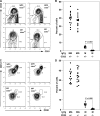Enhancement and suppression of signaling by the conserved tail of IgG memory-type B cell antigen receptors
- PMID: 17420266
- PMCID: PMC2118534
- DOI: 10.1084/jem.20061923
Enhancement and suppression of signaling by the conserved tail of IgG memory-type B cell antigen receptors
Abstract
Immunological memory is characterized by heightened immunoglobulin (Ig) G antibody production caused in part by enhanced plasma cell formation conferred by conserved transmembrane and cytoplasmic segments in isotype-switched IgG B cell receptors. We tested the hypothesis that the IgG tail enhances intracellular B cell antigen receptor (BCR) signaling responses to antigen by analyzing B cells from Ig transgenic mice with IgM receptors or chimeric IgMG receptors containing the IgG tail segment. The IgG tail segment enhanced intracellular calcium responses but not tyrosine or extracellular signal-related kinase (ERK) phosphorylation. Biochemical analysis and crosses to CD22-deficient mice established that IgG tail enhancement of calcium and antibody responses, as well as marginal zone B cell formation, was not due to diminished CD22 phosphorylation or inhibitory function. Microarray profiling showed no evidence for enhanced signaling by the IgG tail for calcium/calcineurin, ERK, or nuclear factor kappaB response genes and little evidence for any enhanced gene induction. Instead, almost half of the antigen-induced gene response in IgM B cells was diminished 50-90% by the IgG tail segment. These findings suggest a novel "less-is-more" hypothesis to explain how switching to IgG enhances B cell memory responses, whereby decreased BCR signaling to genes that oppose marginal zone and plasma cell differentiation enhances the formation of these key cell types.
Figures






References
-
- Ahmed, R., and D. Gray. 1996. Immunological memory and protective immunity: understanding their relation. Science. 272:54–60. - PubMed
-
- Gray, D. 1993. Immunological memory. Annu. Rev. Immunol. 11:49–77. - PubMed
-
- Reth, M. 1992. Antigen receptors on B lymphocytes. Annu. Rev. Immunol. 10:97–121. - PubMed
-
- Achatz, G., L. Nitschke, and M.C. Lamers. 1997. Effect of transmembrane and cytoplasmic domains of IgE on the IgE response. Science. 276:409–411. - PubMed
-
- Kaisho, T., F. Schwenk, and K. Rajewsky. 1997. The roles of gamma 1 heavy chain membrane expression and cytoplasmic tail in IgG1 responses. Science. 276:412–415. - PubMed
Publication types
MeSH terms
Substances
Associated data
- Actions
- Actions
- Actions
- Actions
- Actions
- Actions
- Actions
- Actions
- Actions
- Actions
LinkOut - more resources
Full Text Sources
Molecular Biology Databases
Miscellaneous

